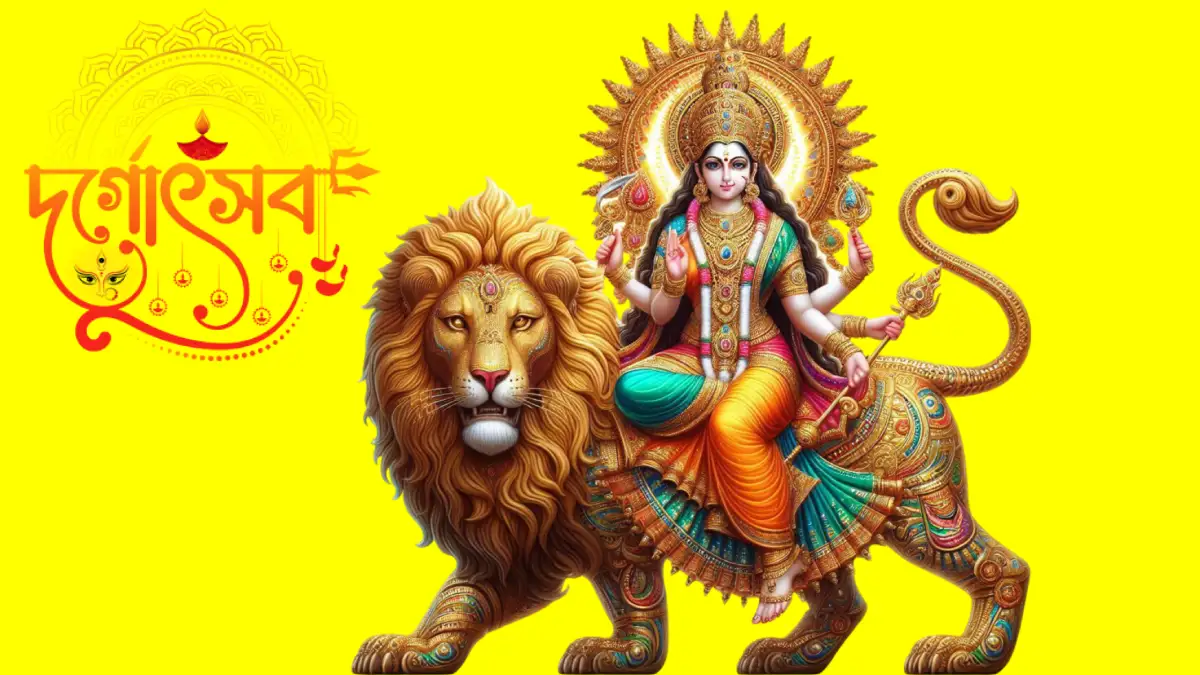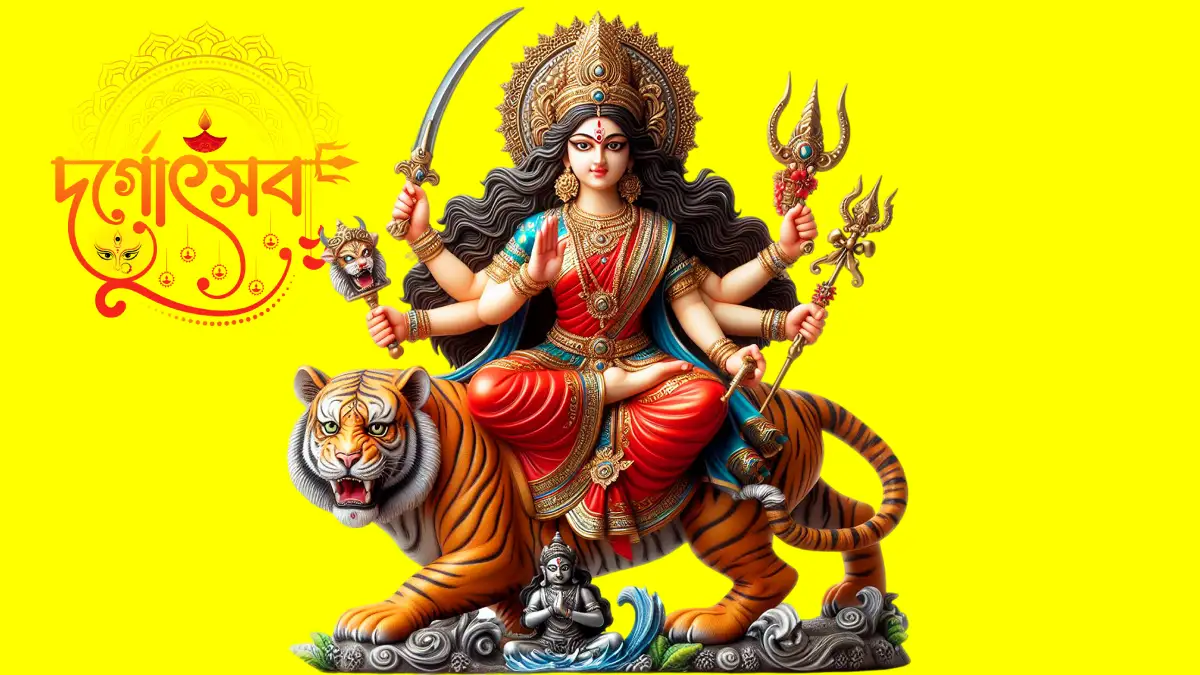Durga Puja, also known as Durgotsava or Shaaradotsava, is one of the most significant and vibrant festivals celebrated in the Indian subcontinent. This annual festival honors the Hindu goddess Durga and commemorates her victory over the buffalo demon Mahishasura, symbolizing the triumph of good over evil.

Durga Puja is rich with traditional rituals that are deeply symbolic and spiritually significant. Here are some of the key rituals observed during the festival:
Mahalaya
The festival begins with Mahalaya, which marks the arrival of Goddess Durga on earth. On this day, people perform Tarpan, a ritual where they offer prayers to their ancestors at riverbanks.
Shashthi
The main festivities start on the sixth day, known as Shashthi. This day is marked by the unveiling of the idol of Goddess Durga in the pandals. The ritual of Bodhon is performed, which involves invoking the goddess and welcoming her.
Saptami
On the seventh day, Saptami, the ritual of Nabapatrika is performed. This involves the bathing of nine plants, symbolizing the nine forms of the goddess, in holy water. These plants are then placed beside the idol of Durga.
Ashtami
The eighth day, Ashtami, is considered the most important day of Durga Puja. The day begins with Kumari Puja, where young girls are worshipped as embodiments of the goddess. The main ritual of the day is Sandhi Puja, performed at the juncture of Ashtami and Navami, symbolizing the moment when Durga killed the demon Mahishasura.
Navami
The ninth day, Navami, involves the Maha Aarti, a grand prayer ceremony. Devotees offer special prayers and seek blessings from the goddess. This day is also marked by feasting and cultural performances.
Vijayadashami
The festival concludes on the tenth day, Vijayadashami. On this day, the idols of Durga and her children are taken in grand processions for immersion in rivers or other water bodies, symbolizing her return to her heavenly abode. This ritual, known as Visarjan, is accompanied by chants, music, and dance. Another significant ritual is Sindoor Khela, where married women smear each other with vermilion, wishing for marital bliss.
Additional Rituals
- Dhuno Pora: Women perform this ritual by holding burning incense in their hands and moving around the idol, believed to purify the environment.
- Dhunuchi Naach: A traditional dance performed with incense burners, adding to the festive atmosphere.
These rituals, steeped in tradition and devotion, make Durga Puja a vibrant and spiritually enriching experience. Each ritual has its own significance and adds to the grandeur of the festival, making it a time of joy, reflection, and community bonding.
Origins and Mythology
The origins of Durga Puja are deeply rooted in Hindu mythology. According to the legends, Mahishasura, a powerful demon, was granted a boon that made him nearly invincible. His tyranny over the heavens and the earth prompted the gods to create Goddess Durga, a powerful deity embodying the collective energy of all the gods. Durga, riding a lion and armed with divine weapons, battled Mahishasura for nine days and nights, ultimately defeating him on the tenth day, known as Vijayadashami.
The Festivities
Durga Puja is celebrated with immense fervor, particularly in the eastern states of India such as West Bengal, Assam, Odisha, and Tripura, as well as in Bangladesh. The festival spans ten days, with the last five days being the most significant. The celebrations begin with Mahalaya, which marks the advent of the goddess. The main rituals start on the sixth day, known as Shashthi, and continue until Vijayadashami.
During these days, beautifully crafted idols of Goddess Durga, along with her children Lakshmi, Saraswati, Ganesha, and Kartikeya, are installed in elaborately decorated pandals (temporary structures). These pandals often depict various themes, ranging from traditional to contemporary, and are a major attraction for visitors.
Cultural Significance
Durga Puja is not just a religious event but a cultural extravaganza. It is a time for family reunions, feasting, and cultural performances. People dress in their finest attire, visit pandals, and participate in various cultural activities such as dance, music, and drama. The festival also includes rituals like the Sandhi Puja, which marks the moment when Ashtami (the eighth day) ends and Navami (the ninth day) begins, and the Sindoor Khela, where married women smear each other with vermilion on Vijayadashami.
The Final Day: Vijayadashami
The festival culminates on Vijayadashami, the day of victory. On this day, the idols of Durga and her children are taken in grand processions to nearby rivers or other water bodies for immersion, symbolizing the goddess’s return to her heavenly abode. This ritual, known as Visarjan, is accompanied by chants, music, and dance, creating a poignant yet joyous atmosphere.
Durga Puja in Modern Times
In recent years, Durga Puja has gained international recognition and was inscribed on the UNESCO Representative List of the Intangible Cultural Heritage of Humanity in 2021. The festival continues to evolve, incorporating modern elements while preserving its traditional essence. It remains a powerful symbol of cultural identity and communal harmony, bringing people together in celebration of life, victory, and the divine feminine energy.
Durga Puja is more than just a festival; it is a celebration of resilience, creativity, and the enduring spirit of humanity. Whether you are a participant or an observer, the vibrant colors, the rhythmic beats of the dhak (traditional drum), and the infectious energy of the celebrations are sure to leave an indelible impression on your heart.

